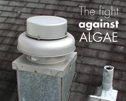In February 2005, NRCA issued a Special Report titled "Use of treated wood in roof assemblies," notifying its members of changes in the chemical treatment of preservative-treated wood and the resulting concerns with fastener corrosion associated with the new chemical treatments. Because NRCA's concerns with possible corrosion continue, following is current information and NRCA's latest recommendations.
Background
As of January 2004, wood preservers voluntarily removed wood treated with chromated copper arsenate (CCA) from consumer markets, citing concerns the arsenic and chromium contained in CCA pose possible environmental concerns in exposed-to-weather applications. CCA treatment had been used successfully for preservative-treated wood since the early 1930s, and those in the roofing industry had grown accustomed to specifying and using CCA-treated lumber as wood blocking and wood nailers in roof assemblies.
Wood preservers have introduced a number of preservative treatment substitutes, including alkaline copper quant type C (ACQ-C), alkaline copper quant type D carbonate (ACQ-D carbonate), micronized copper quant (MCQ), copper azole (CBA-A, CA-B), ammoniacal copper zinc arsenate (ACZA), sodium borate disodium octaborate tetrahydrate (SBX/DOT) and zinc borate.
Each preservative treatment has a number of variations, and preservative-treated wood with different treatment retention levels is available for differing exposure conditions. Wood preservers acknowledge current treatment formulations and retention levels continue to evolve.
Corrosion concerns
Published reports indicate most current-generation preservative treatments are more corrosive than CCA. For example, ACQ-D carbonate, CA-B and ACZA have been shown to exhibit more than twice the corrosiveness of CCA. SBX/DOT and zinc borate treatments have been shown to be slightly less corrosive than CCA.
A complicating factor in specifying treatments for preservative-treated wood is the specific preservative treatment used is not always readily identifiable to users by the wood's appearance, markings or product labeling.
The preservative-treated wood industry recommends hot-dip galvanized or stainless-steel fasteners, anchors and hardware be used with preservative-treated wood.
NRCA's recommendations
To address concerns regarding corrosion associated with the current generation of preservative-treated wood, NRCA continues to recommend fasteners complying with ASTM A153, "Standard Specification for Zinc Coating (Hot-Dip) on Iron and Steel Hardware," be used with preservative-treated wood. Type 304 or Type 316 stainless-steel fasteners and connectors are recommended for maximum corrosion resistance.
Carbon steel, aluminum and electroplated galvanized steel fasteners and connectors should not be used with preservative-treated wood because of the potential for accelerated corrosion.
Fasteners with proprietary anti-corrosion coatings may be acceptable for use with preservative-treated wood. NRCA recommends you consult fastener manufacturers for more information.
As an alternative, NRCA believes nontreated construction-grade wood is suitable for use in roof assemblies as blocking and nailers provided reasonable measures are taken to ensure the nontreated wood remains reasonably dry while in service. NRCA considers conventional corrosion-resistant fasteners appropriate when nontreated construction-grade wood is used.
NRCA's recommendations for addressing corrosion concerns related to the current generation of preservative-treated wood are unchanged from its February 2005 Special Report and have been incorporated into The NRCA Roofing Manual.
Mark S. Graham is NRCA's associate executive director of technical services.


